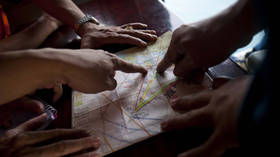‘Tit for tat’: Philippines will stamp Chinese visitors’ passports with map of disputed territories

Chinese visitors to the Philippines will have their passports stamped with a special visa stamp featuring the map of disputed territories in protest against Beijing’s claims to them.
Philippines Foreign Secretary Teodoro Locsin Jr announced the new policy in Manila on Monday, and President Rodrigo Duterte announced his approval on Tuesday.The new stamp, used specifically for Chinese passports, will include the Philippines exclusive economic zone – which includes parts of the South China Sea that Beijing is claiming as its own.
Also on rt.com Echoes of WWII: Pompeo goes on South Pacific blitz to ‘counter China’The in-your-face move is a protest against Chinese nationals’ passports featuring the same map, but marked in accordance with Beijing’s territorial policies. It replaces the previous measure of putting visa stamps on Chinese visitors’ application forms instead of their passports, which was also done “to avoid the Philippines being misconstrued as legitimizing” Beijing’s claims.
“So tit for tat,” Locsin concluded in a tweet. He also said the new policy will make it easier to track Chinese visitors, whose visas were “hitherto stamped on slips of paper no one could keep track of.”
The stamp has the map of the entire Philippine EZZ to its widest extent including Benham Rise along with other territorial claims. So tit for tat. https://t.co/gj1PK4Izrm
— Teddy Locsin Jr. (@teddyboylocsin) August 6, 2019
Waters of the South China Sea are subject to competing claims by several nations surrounding it, including China’s ‘nine-dash line,’ which puts most of the territory under Beijing’s control. The Philippines includes roughly half of the area in its exclusive economic zone, and in 2016 obtained a non-binding UN ruling invalidating China’s claim.
If you like this story, share it with a friend!














